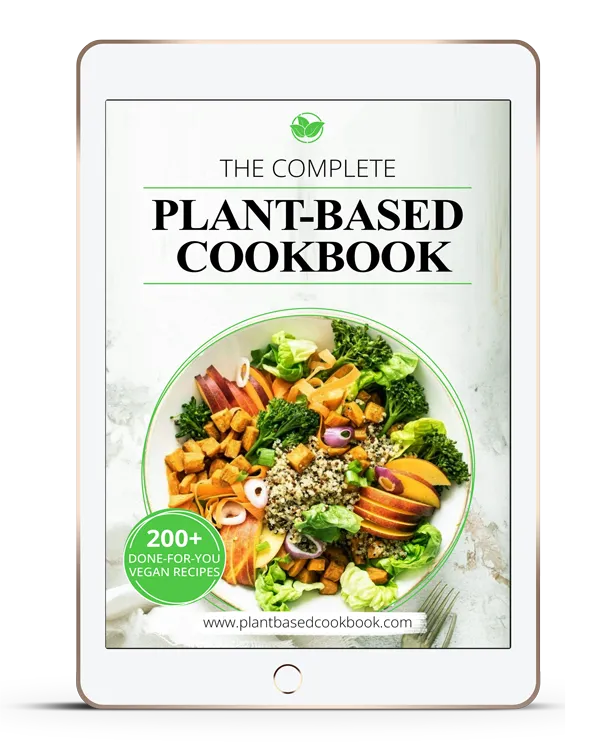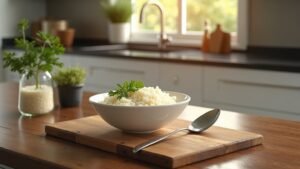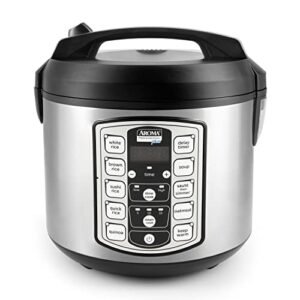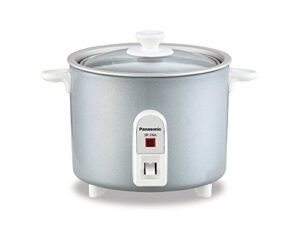Have you ever found yourself with a fridge full of leftovers after a big family dinner? I know I have! It can be overwhelming to figure out what to do with all that extra food, especially when it comes to cooked rice. But don’t worry, we’ve got you covered! In this article, we’ll show you how to turn that leftover rice into a delicious and comforting dish – congee!
Congee, also known as rice porridge, is a versatile dish that can be enjoyed for breakfast, lunch, or dinner. It’s warm, creamy, and packed with flavor. And the best part? It’s incredibly easy to make, especially when you have leftover rice on hand!
By using your leftover cooked rice, you’re not only saving time and avoiding food waste, but you’re also creating a dish with a unique texture. Leftover rice tends to have a drier texture, which makes it perfect for congee. When cooked in broth or water, the rice grains easily break down, resulting in a smooth and creamy porridge.
Whether you prefer to make your congee on the stovetop or in a rice cooker, we’ll guide you through the process step by step. You’ll learn how to blend the rice with liquid, simmer it to perfection, and add your favorite toppings to personalize your congee experience.
So, get ready to transform your leftover rice into a bowl of warm and comforting congee. Let’s dive in and discover the easy and delicious world of congee with leftover rice!
Table of Contents
ToggleWhy Use Leftover Rice for Congee?
Using leftover rice for congee is a great way to repurpose cooked rice and reduce food waste. Leftover rice tends to have a drier texture, which is perfect for making congee as it will easily break down during cooking, resulting in a creamy and smooth texture. Additionally, using leftover rice cuts down on cooking time, as the rice is already cooked and only needs to be heated through. This makes it a convenient option for a quick and satisfying meal.
When making congee with leftover rice, the grains have already been cooked once, which helps to speed up the cooking process. Instead of starting from scratch with uncooked rice, you can simply heat up the leftover rice with some broth or water to create a delicious and comforting congee.
Another advantage of using leftover rice is that it adds flavor to the congee. The rice absorbs the flavors of the previous meal it was served with, giving the congee a more complex and rich taste. This adds depth to the dish without requiring extra seasoning or ingredients.
Whether you have a small amount of leftover rice or a larger quantity, it can be easily transformed into a satisfying bowl of congee. This not only saves you time and money but also helps to reduce food waste, making it a sustainable choice for your meals.
If you’re looking for a simple and delicious way to use up your leftover rice, making congee is a fantastic option. It allows you to enjoy a comforting and flavorful meal while minimizing food waste. Stay tuned for the next section, where we’ll dive into the step-by-step process of making congee with leftover rice on the stove.
How to Make Congee with Leftover Rice on the Stove
Making congee with leftover rice on the stove is a straightforward process. Here’s a step-by-step guide to help you create a delicious bowl of congee using your leftover rice:
Step 1: Blend the cooked rice
Start by blending the cooked rice with some broth or water. This will help break down the rice grains and create a smooth consistency in your congee. You can use a blender or food processor for this step.
Step 2: Transfer to a heavy-bottom pot
Once the rice is blended, transfer the mixture to a heavy-bottom pot. This type of pot ensures even heat distribution and prevents the congee from sticking to the bottom.
Step 3: Bring to a boil
Place the pot on the stove and bring the congee mixture to a boil over medium-high heat. Stir occasionally to prevent it from sticking to the bottom of the pot.
Step 4: Reduce heat and simmer
Once the congee reaches a boil, reduce the heat to low and let it simmer. Stir occasionally to prevent the rice from clumping together and sticking to the pot.
Step 5: Cook until desired consistency
Continue simmering the congee until it reaches your desired consistency. If you prefer a thicker congee, cook it for a shorter time, and for a thinner consistency, cook it for longer.
Step 6: Add protein (optional)
If you’d like to add protein to your congee, such as pork, chicken, or fish, you can do so during the cooking process. Simply add the protein to the pot and let it cook until heated through.
Now that you know how to make congee with leftover rice on the stovetop, let’s explore how to make it in a rice cooker in the next section.
How to Make Congee with Leftover Rice in a Rice Cooker
Making congee with leftover rice in a rice cooker is a convenient option for those who prefer a set-and-forget method. Here’s a simple step-by-step guide:
- Step 1: Start by blending the cooked rice with some broth or water to create a smooth consistency.
- Step 2: Pour the blended rice mixture into the inner pot of the rice cooker.
- Step 3: Select the “quick cook” setting on the rice cooker.
- Step 4: Let the rice cooker cook the congee to the desired consistency.
Similar to the stove method, you can add protein to the congee after it is done cooking and let it gently cook in the residual heat. Once the congee is ready, serve it hot and enjoy!
Variations and Toppings for Congee with Leftover Rice
Congee is an incredibly versatile dish that can be customized to suit your taste preferences. Whether you’re looking to add more flavor or texture, there are numerous variations and toppings that can elevate your congee experience. Here are some ideas to get you started:
1. Congee Variations
- Add century eggs for a rich and savory flavor.
- Incorporate ground pork or chicken for added protein.
- Enhance the seafood taste by adding fish slices.
- For a vegetarian option, consider adding firm tofu cubes.
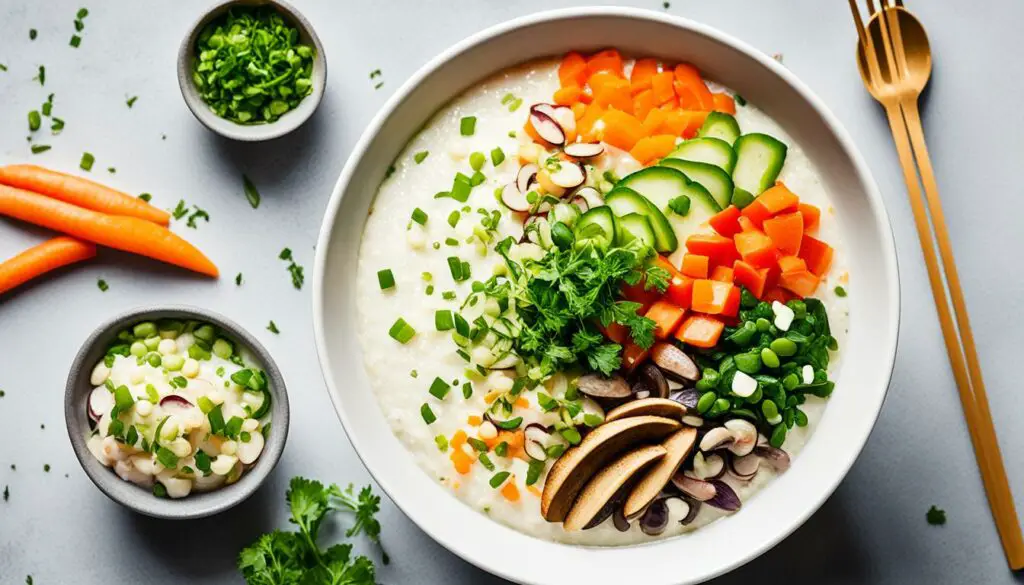
2. Congee Toppings
- Garnish your congee with fresh minced ginger for a subtle kick.
- Add finely chopped green onion for a pop of color and freshness.
- Drizzle a little bit of sesame oil to impart a nutty aroma.
These toppings not only enhance the flavors but also add visual appeal to your bowl of congee.
Feel free to experiment and mix and match different variations and toppings to create a personalized congee that suits your preferences. Whether you prefer something classic or want to try something unique, the possibilities are endless when it comes to making the perfect bowl of congee.
Health Benefits of Congee with Leftover Rice
Congee with leftover rice offers several health benefits. Rice is a good source of carbohydrates, providing energy for the body. Additionally, congee is easy to digest, making it a gentle and comforting option for individuals with a sensitive stomach or those recovering from illness. The addition of protein and vegetables in the congee can also contribute to a well-rounded and nourishing meal. By using leftover rice, you can reduce food waste and make a nutritious dish at the same time.
1. Good Source of Carbohydrates
Rice, the main ingredient in congee, is a staple that provides carbohydrates, which are essential for energy production in the body.
2. Easy to Digest
With its smooth and creamy texture, congee is gentle on the stomach and easy to digest. This makes it a soothing option for people with digestive issues or those recovering from illness.
3. Nourishing and Balanced Meal
By adding protein such as chicken, fish, or tofu, and vegetables to your congee, you can create a well-rounded meal that provides essential nutrients. This combination of ingredients ensures that you get a balanced meal in one bowl.
4. Helps Reduce Food Waste
Using leftover rice for congee is a smart way to minimize food waste. Instead of throwing away excess cooked rice, you can repurpose it into a delicious and nutritious meal.
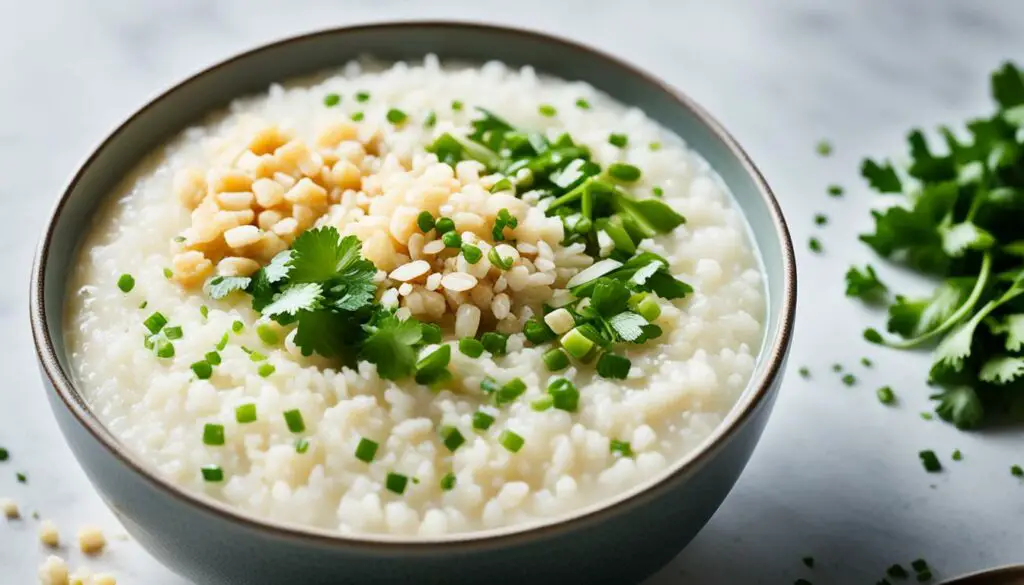
Including congee with leftover rice in your diet is a win-win situation. Not only does it provide the health benefits mentioned above, but it also allows you to get creative with flavors and toppings to suit your taste preferences. So next time you have leftover rice, consider making a comforting bowl of congee for a satisfying and nutritious meal.
Tips for Making the Perfect Congee with Leftover Rice
Making congee with leftover rice is a straightforward process, but here are some tips to ensure success:
Adjust the amount of liquid: The type of cooked rice you are using will determine the amount of liquid needed for your congee. Brown rice may require slightly more liquid compared to white rice. Start with a 1:4 ratio of rice to liquid and adjust as needed to achieve your desired consistency.
Monitor the cooking time: Cooking time plays a crucial role in determining the texture of your congee. If you prefer a thicker congee, cook it for a shorter time. For a thinner consistency, cook it for longer. Keep an eye on the congee as it simmers, and adjust the cooking time accordingly.
Experiment with ingredients and toppings: Don’t be afraid to get creative with your congee! Try adding different ingredients like sliced mushrooms, shredded chicken, or chopped vegetables to enhance the flavor. Additionally, experimenting with toppings such as crispy fried shallots, chopped peanuts, or a sprinkle of cilantro can take your congee to the next level.
Congee Tips in a Nutshell:
| Tips | Description |
|---|---|
| Adjust Liquid Amount | Use more liquid for brown rice and adjust to your desired consistency. |
| Monitor Cooking Time | Cook shorter for thicker congee, longer for a thinner consistency. |
| Experiment with Ingredients | Add your favorite proteins and vegetables for a personalized touch. |
| Try Different Toppings | Enhance the flavor with toppings like fried shallots, peanuts, or herbs. |
Conclusion
Congee with leftover rice is a simple and delicious way to transform your leftover rice into a warm and comforting meal. Whether you choose to make it on the stove or in a rice cooker, the process is straightforward and yields a creamy and smooth congee.
By using leftover rice, you can save time and reduce food waste, while also enjoying a satisfying and nourishing dish. With the added flexibility of variations and toppings, you can personalize your congee experience and create a dish that suits your taste preferences.
So don’t let your leftover rice go to waste! Try making congee with leftover rice today and enjoy a cozy and flavorful meal that is both easy to prepare and incredibly satisfying.
FAQ
Why should I use leftover rice for congee?
Using leftover rice for congee is a great way to repurpose cooked rice and reduce food waste. Leftover rice tends to have a drier texture, which is perfect for making congee as it will easily break down during cooking, resulting in a creamy and smooth texture. Additionally, using leftover rice cuts down on cooking time, as the rice is already cooked and only needs to be heated through.
How do I make congee with leftover rice on the stove?
Making congee with leftover rice on the stove is a straightforward process. Start by blending the cooked rice with some broth or water to break down the rice grains and create a smooth consistency. Then, transfer the blended rice mixture to a heavy-bottom pot and bring it to a boil. Reduce the heat and simmer until the congee reaches your desired consistency. If desired, you can also add protein, such as pork, chicken, or fish, to the congee and cook it until heated through.
How do I make congee with leftover rice in a rice cooker?
Making congee with leftover rice in a rice cooker is a convenient option. After blending the cooked rice with some broth or water, you can pour the mixture into the inner pot of the rice cooker and select the “quick cook” setting. The rice cooker will automatically cook the congee to the desired consistency. Similar to the stove method, you can add protein to the congee after it is done cooking and let it gently cook in the residual heat.
What are some variations and toppings for congee with leftover rice?
Congee is incredibly versatile and can be customized to suit your taste preferences. Some popular variations include adding century eggs, ground pork, chicken, fish slices, or firm tofu cubes. For toppings, you can garnish the congee with fresh minced ginger, finely chopped green onion, or a drizzle of sesame oil. Get creative and make your congee unique and delicious!
What are the health benefits of congee with leftover rice?
Congee with leftover rice offers several health benefits. Rice is a good source of carbohydrates, providing energy for the body. Additionally, congee is easy to digest, making it a gentle and comforting option for individuals with a sensitive stomach or those recovering from illness. The addition of protein and vegetables in the congee can also contribute to a well-rounded and nourishing meal.
What are some tips for making the perfect congee with leftover rice?
When making congee with leftover rice, adjust the amount of liquid based on the type of cooked rice you are using. Brown rice may require slightly more liquid compared to white rice. Additionally, monitor the cooking time and adjust it based on your desired consistency. If you prefer a thicker congee, cook it for a shorter time, and for a thinner consistency, cook it for longer. Lastly, don’t be afraid to experiment with different ingredients and toppings to find your favorite combination.


